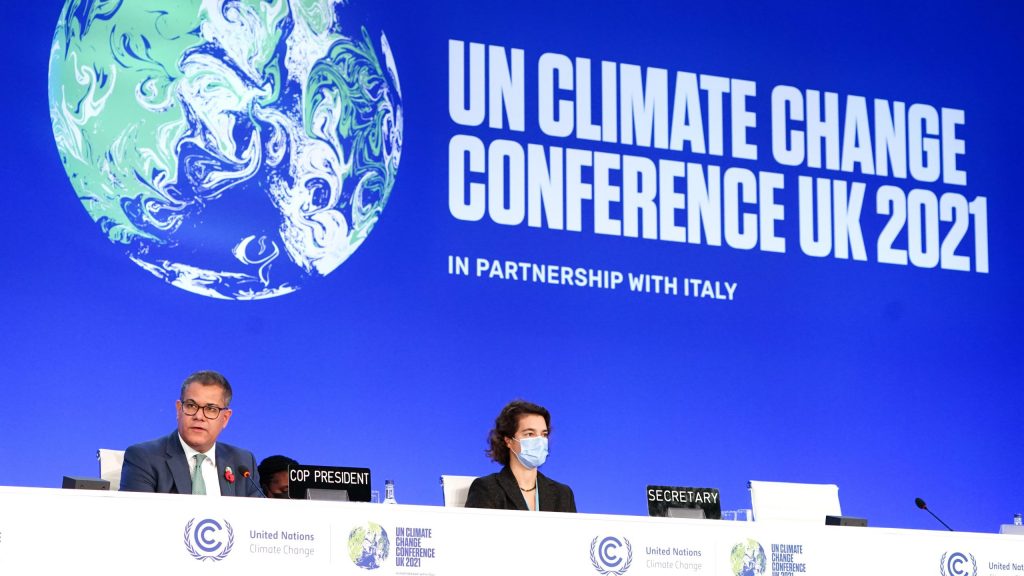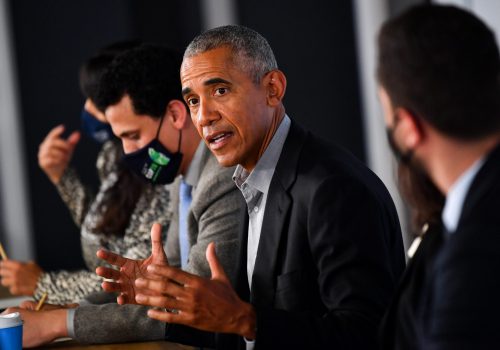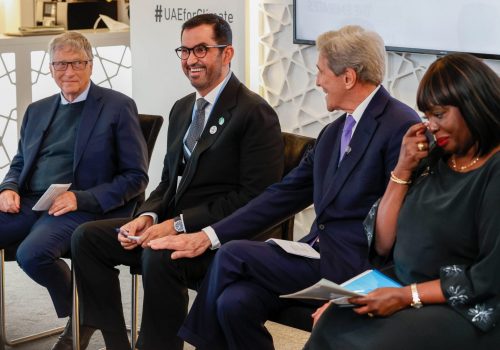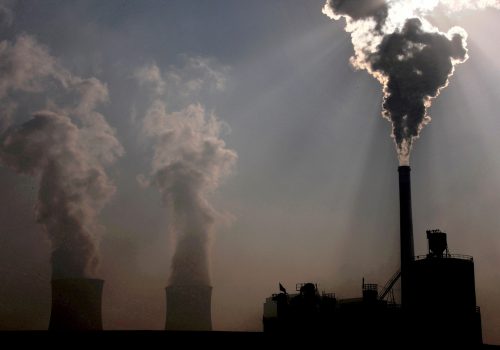The United Nations Conference of the Parties (COP26) concluded Saturday in Glasgow, Scotland, as nearly two hundred nations signed on to a deal that called on governments to enact stricter emissions reductions and for wealthy nations to double funding to protect countries most at risk—though the language about coal was watered down at the last minute.
Throughout the twelve-day event, our team on the ground at COP26 and elsewhere kept tabs on the range of relevant issues—from nuclear energy to climate finance—as they developed, while also bringing together high-level figures to hash out solutions.
The progress and pitfalls went far beyond Saturday’s carefully negotiated final agreement. Here’s a selection of our experts’ commentary that dug deeper to explain what really mattered at COP26 (and what didn’t):
What the energy transition still needs: a price on carbon
Global Energy Center Deputy Director Reed Blakemore weighed in with his big takeaways as the summit wrapped up.
“COP26 observers will leave Glasgow with a number of positive (and tangible!) takeaways from the past two weeks—a global methane pledge, an apparent opportunity for the United States and China to more directly collaborate on climate action, and a resounding commitment from private finance to put a huge sum of money on the table in the pursuit of climate action, just to name a few.
Though looking beyond the headlines, here are a few interesting threads emerging out of COP26 that will be worth watching in the coming year, based on my observations of the discourse, speeches, meetings, and pull-asides:
- In completely separate discussions about mineral supply chains, sustainable aviation fuels, and small modular nuclear reactors, business leaders all concluded that a price on carbon is key to taking their business to the next level. That shows us that continued inaction from policymakers to establish a market for carbon is becoming the biggest obstacle to unlocking the next phase of energy transition.
- There’s fast-growing interest from NGOs, policymakers, and business leaders alike in stimulating behavioral change by energy consumers to reduce their consumption. This isn’t necessarily a new idea, but it now has an angle that’s similar to an oft-referenced challenge from the fossil-fuel industry: Forcing production of undesired energy sources out of the energy mix without corresponding changes in demand will just shift management of those fossil-fuel assets to other, possibly less accountable parties, rather than eliminate it outright.
- The current energy crisis has forced a reckoning as to the role of oil and gas in the energy transition, though there is still significant daylight between the clean-energy and oil-and-gas policy camps as to what that role looks like, particularly in relation to the role of climate finance in cleaning up emissions from existing oil and gas infrastructure.
- Not nearly enough attention is being paid by clean-energy technologists to clean-energy supply chains—especially regarding the scale of minerals and materials that will be required to meet clean-energy deployment goals. If not taken seriously by business leaders and policymakers alike, insufficient supplies of transition minerals such as lithium, copper, and rare-earth elements will foment the next crisis in the energy transition.”
The United States got more serious about nuclear power….
Jennifer T. Gordon, managing editor and senior fellow at the Council’s Global Energy Center, broke down why the US Nuclear Futures Initiative, which was announced in Glasgow on November 3, is so important:
“The US Department of State’s announcement of the $25 million Nuclear Futures Package—aimed at helping a wide array of countries acquire nuclear energy technologies—at COP26 … was a major milestone, and an implicit argument for the role of nuclear energy as a necessary tool in the fight against climate change. The coordination on this issue of several US government entities—including State and the Departments of Commerce and Energy, among others—also shows the importance of a whole-of-government approach to civil nuclear exports.
That the Nuclear Futures Package was announced by Ambassador Bonnie Jenkins, Under Secretary for Arms Control and International Security, demonstrates the intrinsic relationship between US civil nuclear export leadership and global safety and nonproliferation. Countries interested in purchasing nuclear energy technologies from the United States must adhere to the highest standards of safety and nonproliferation.
The funding is intended to build capacity for nuclear energy programs around the world, but not the reactors themselves. It will cover areas such as equipment, feasibility studies, and technical collaboration. While the eventual reactors will almost certainly carry much larger price tags, financing questions can be solved as long as the foundations of civil nuclear cooperation are built—which is exactly what this new initiative will do.”
…but it also gave up moral ground.
Matthew Bryza, a nonresident senior fellow at the Global Energy Center, believes the United States was wrong in failing to join the multinational pledge to move off coal, which included dozens of countries:
“Underlying the fundamental goal of COP26—to implement the Paris Climate Accord—is a moral argument: Because we all share this planet, all countries are obligated to make national sacrifices to achieve net-zero carbon emissions by 2050. Persuading the Global South to ditch the carbon-rich energy on which the Global North grew wealthy requires strong moral leadership.
COP26 provides the United States a crucial chance to help move the world from parochialism to collective self-preservation—but it risks squandering this monumental opportunity.
Given President Joe Biden’s goal of a carbon-free electricity system in the United States by 2035, it seemed natural the United States would join this week’s multinational pledge to move away from coal. Instead, it joined China and other heavy coal users, such as India and Australia, in refusing to join the agreement.
The timing seems politically suspicious, coinciding with final deliberations in the Congress on Biden’s historic spending packages for infrastructure and economic recovery. Perhaps understandably, the president’s team wants to avoid risking the crucial vote of Democratic Sen. Joe Manchin—who hails from West Virginia, where coal is king. Without Manchin’s vote, Biden’s historic spending packages will be doomed (maybe along with his presidency).
Succumbing to parochial interests is the opposite of moral leadership. The US browbeating of developing countries such as South Africa to ditch the coal on which its economic future heavily depends will now ring hollow. Similarly, pressing other countries of the Global South to sign on to the landmark agreement to fight deforestation (which may be COP 26’s biggest achievement so far) will seem selfish and unfair. That may be why Indonesia appears set to back out of that agreement.
Refreshingly, Biden ‘talked the talk’ when he claimed during his first presidential visit to Europe in June that “America is back.” Now, at COP 26, it’s essential to ‘walk the walk.'”
Why that coal pledge is complicated…
Ellen Wald, a nonresident fellow at the Council’s Global Energy Center, wasn’t exactly celebrating the agreement:
“These commitments are being hailed as historic—but how meaningful can we expect them to be?
A quick look at what’s happening today with coal suggests they won’t make much of an impact in reducing global emissions. In the United Kingdom, for instance, power generators have now been forced to fire up dormant coal plants as the amount of electricity being generated from wind fell to very low levels during periods of peak demand. In China, meanwhile, the government has been pressing coal mines to boost production because the high cost of natural gas has recently caused widespread power cuts. (China’s daily coal production hit 11.2 million tons yesterday— an increase of 1 million from early October.)
And in the United States, coal consumption has declined significantly over the past fifteen years as natural gas replaced coal as a key fossil fuel for electricity generation. But the country is now facing an unprecedented dislocation in energy prices, with the potential for consumers across the country to face record high prices this winter. The culprit is likely natural gas, which is more expensive now than it has been for years, and in much greater demand than ever before, because of this turn away from coal. According to the Energy Information Agency, US coal production rose during the second quarter of 2021, while exports increased by 6.9 percent in the second quarter of 2021. This is not a true pivot away from coal.
Notably, neither China nor the United States nor India—all major coal producers and consumers—signed on. Without these nations, this week’s pledges lack enforcement measures. Given how quickly nations have stepped up coal production to meet electricity demand which is unmet by natural gas, and to relieve high electricity prices, it doesn’t seem like coal is going away anytime soon. It cannot be the alternative when the wind doesn’t blow, the sun isn’t shining, and when natural gas supplies are disrupted.”
…and what the methane agreement means.
George Frampton, a distinguished senior fellow and the director of the Transatlantic Climate Policy Initiative at the Global Energy Center, weighs in on the pledge by world leaders on November 2 to cut methane emissions 30 percent by 2030:
“First announced in September, the Global Methane Pledge now includes almost ninety countries—sixty of which have signed up in just the past few weeks—which comprise half of the world’s top thirty methane emitters. They account for two-thirds of the global economy. Brazil, a top-five emitter, just joined this week. So the Kerry team has been doing a lot of successful work on this issue.
The less interesting thing about the announcement is that Biden had already made a commitment to reduce methane, and the Environmental Protection Agency is effectively just reinstating—and slightly expanding—a rule it released at the end of the Obama administration, developed as a joint pledge with Canada to reduce methane 30 percent by 2030. (The Obama rule was cancelled by Congress through the Congressional Review Act during the Trump administration.)
More interesting is not only the large number of countries that signed on to methane reduction targets at COP26, but also those that didn’t—some of the world’s largest producers. For the European Union, Japan, South Korea, and others that don’t generate much methane, developing policy is about slowly limiting, or disfavoring, gas and oil from countries that don’t do a good job in reducing methane leakage.
Saudi Arabia and the United Arab Emirates were among those who signed up, although they are not (as some might suspect) among the very biggest emitters because their oil and gas systems are relatively modern and control leaks. But some of the biggest emitters who do not do such a good job—including Russia, China, and India—are not yet ready to make the commitment.”
Women are central to a climate solution.
During a Global Environment Facility panel on adaptation innovation on November 8, Jorge Gastelumendi, director of global policy for the Council’s Adrienne Arsht-Rockefeller Foundation Resilience Center, explained the critical role of women in boosting climate resilience:
“Women and children are way more affected than men by climate change, and we need women working in [climate] finance and micro-finance. We need them—not because it’s a nice thing to have, but without social resilience, without social justice, it’s impossible to have climate resilience and climate justice.”
Further reading
Sun, Oct 31, 2021
Experts react: Can COP26 negotiators sustain the momentum?
New Atlanticist By
Atlantic Council experts deliver insightful analysis on the COP26 developments that will matter most in the fight against climate change.
Wed, Nov 3, 2021
Can innovation save the planet?
New Atlanticist By Dan Peleschuk
Policy heavyweights Bill Gates and John Kerry and experts from the UAE and Kenya joined the Atlantic Council at COP26 in Glasgow, Scotland, to discuss the technological breakthroughs that can make a lasting impact on climate change.
Thu, Nov 4, 2021
Bending the Asia-Pacific coal curve is critical to taming climate change. COP26 is making progress.
New Atlanticist By Robert F. Ichord, Jr.
Recent coal pledges are new examples of the type of cooperation with emerging and developing countries that will be necessary to curb emissions and help countries implement their national climate commitments.
Image: Alok Sharma, president of COP26, takes part in a plenary session during the official final day of the summit in Glasgow on November 12, 2021. Photo by PA/REUTERS



